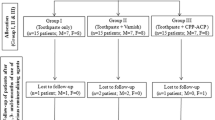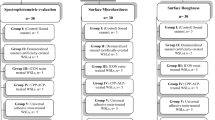Abstract
This study aims to investigate the effect of topical applications of 10% casein phosphopeptide–amorphous calcium phosphate (CPP–ACP) on white spot lesions (WSL) detected after treatment with fixed orthodontic appliances. Sixty healthy adolescents with ≥1 clinically visible WSL at debonding were recruited and randomly allocated to a randomised controlled trial with two parallel groups. The intervention group was instructed to topically apply a CPP–ACP -containing agent (Tooth Mousse, GC Europe) once daily and the subjects of the control group brushed their teeth with standard fluoride toothpaste. The intervention period was 4 weeks and the endpoints were quantitative light-induced fluorescence (QLF) on buccal surfaces of the upper incisors, cuspids and first premolars and visual scoring from digital photos. The attrition rate was 15%, mostly due to technical errors, and 327 lesions were included in the final evaluation. A statistically significant (p < 0.05) regression of the WSL was disclosed in both study groups compared to baseline, but there was no difference between the groups. The mean area of the lesions decreased by 58% in the CPP–ACP group and 26% in the fluoride group (p = 0.06). The QLF findings were largely reflected by the clinical scores. No side effects were reported. Topical treatment of white spot lesions after debonding of orthodontic appliances with a casein phosphopeptide-stabilised amorphous calcium phosphate agent resulted in significantly reduced fluorescence and a reduced area of the lesions after 4 weeks as assessed by QLF. The improvement was however not superior to the “natural” regression following daily use of fluoride toothpaste.
Similar content being viewed by others
References
Derks A, Katsaros C, Frencken JE, van’t Hof MA, Kuijpers-Jagtman AM (2004) Caries-inhibiting effect of preventive measures during orthodontic treatment with fixed appliances. A systematic review. Caries Res 38:413–420
Benson PE, Parkin N, Millett DT, Dyer FE, Vine S, Shah A (2004) Fluorides for the prevention of white spots on teeth during fixed brace treatment. Cochrane Database Syst Rev (3):CD003809
Stecksén-Blicks C, Renfors G, Oscarson ND, Bergstrand F, Twetman S (2007) Caries-preventive effectiveness of a fluoride varnish: a randomized controlled trial in adolescents with fixed orthodontic appliances. Caries Res 41:455–459
Bergstrand F, Twetman S (2003) Evidence for the efficacy of various methods of treating white-spot lesions after debonding of fixed orthodontic appliances. J Clin Orthod 37:19–21
Reynolds EC (2008) Calcium phosphate-based remineralization systems: scientific evidence? Aust Dent J 53:268–273
Reynolds EC, Cai F, Cochrane NJ, Shen P, Walker GD, Morgan MV, Reynolds C (2008) Fluoride and casein phosphopeptide–amorphous calcium phosphate. J Dent Res 87:344–348
Azarpazhooh A, Limeback H (2008) Clinical efficacy of casein derivatives: a systematic review of the literature. J Am Dent Assoc 139:915–924
Sudjalim TR, Woods MG, Manton DJ, Reynolds EC (2007) Prevention of demineralization around orthodontic brackets in vitro. Am J Orthod Dentofacial Orthop 131(705):e1–e9
Andersson A, Sköld-Larsson K, Hallgren A, Petersson LG, Twetman S (2007) Effect of a dental cream containing amorphous cream phosphate complexes on white spot lesion regression assessed by laser fluorescence. Oral Health Prev Dent 5:229–233
Bailey DL, Adams GG, Tsao CE, Hyslop A, Escobar K, Manton DJ, Reynolds EC, Morgan MV (2009) Regression of post-orthodontic lesions by a remineralizing cream. J Dent Res 88:1148–1153
Tranaeus S, Al-Khateeb S, Björkman S, Twetman S, Angmar-Månsson B (2001) Application of quantitative light-induced fluorescence to monitor incipient lesions in caries-active children. A comparative study of remineralisation by fluoride varnish and professional cleaning. Eur J Oral Sci 109:71–75
Gorelick L, Geiger AM, Gwinnett AJ (1982) Incidence of white spot formation after bonding and banding. Am J Orthod 81:93–98
Karlsson L, Lindgren LE, Trollsås K, Angmar-Månsson B, Tranaeus S (2007) Effect of supplementary amine fluoride gel in caries active adolescents. A clinical QLF study. Acta Odontol Scand 65:284–291
Manton DJ, Walker GD, Cai F, Cochrane NJ, Shen P, Reynolds EC (2008) Remineralization of enamel subsurface lesions in situ by the use of three commercially available sugar-free gums. Int J Paediatr Dent 18:284–290
Uysal T, Amasayali M, Koyuturk AE, Sagdic D (2009) Efficiency of amorphous calcium phosphate-containing orthodontic composite and rein modified glass ionomer on demineralization evaluated by a new laser fluorescence device. Eur J Dent 3:127–134
Twetman S, Axelsson S, Dahlgren H, Holm AK, Källestål C, Lagerlöf F, Lingström P, Mejàre I, Nordenram G, Norlund A, Petersson LG, Söder B (2003) Caries-preventive effect of fluoride toothpaste: a systematic review. Acta Odontol Scand 61:347–355
Pretty IA, Pender N, Higham SM (2003) The in vitro detection of early de- and re-mineralization adjacent to bonded orthodontic cleats using quantitative light-induced fluorescence. Eur J Orthod 25:217–223
Aljehani A, Tranaeus S, Forsberg CM, Angmar-Månsson B, Shi XQ (2004) In vitro quantification of white spot enamel lesions adjacent to fixed orthodontic appliances using quantitative light-induced fluorescence and DIAGNOdent. Acta Odontol Scand 62:313–318
Kronenberg O, Lussi A, Ruf S (2009) Preventive effect of ozone on the development of white spot lesions during multibracket appliance therapy. Angle Orthod 79:64–69
Acknowledgement
The study was partly supported by a grant from GC Europe (Belgium) who also provided the test product. The authors would like to thank Pia Hole, Marianne Knudsen, Birgitte Kristensen and Mirko Zelic for their skilful clinical and technical work.
Conflicts of interest
The authors declare that they have no conflict of interest. The authors alone are responsible for the performance and evaluation of the study protocol as well as for the content and writing of the paper.
Author information
Authors and Affiliations
Corresponding author
Rights and permissions
About this article
Cite this article
Bröchner, A., Christensen, C., Kristensen, B. et al. Treatment of post-orthodontic white spot lesions with casein phosphopeptide-stabilised amorphous calcium phosphate. Clin Oral Invest 15, 369–373 (2011). https://doi.org/10.1007/s00784-010-0401-2
Received:
Accepted:
Published:
Issue Date:
DOI: https://doi.org/10.1007/s00784-010-0401-2




